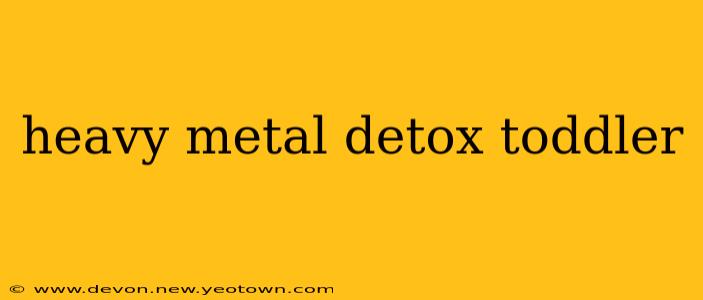The innocent, playful years of toddlerhood should be filled with joy, exploration, and development – not shadowed by the worry of heavy metal toxicity. Unfortunately, exposure to heavy metals like lead, mercury, arsenic, and cadmium can occur through various sources, leaving parents understandably concerned. This guide explores heavy metal detox in toddlers, addressing common questions and providing crucial information for navigating this complex issue. Remember, this information is for educational purposes, and consulting a pediatrician or qualified healthcare professional is paramount before initiating any detox program.
What are the common sources of heavy metal exposure in toddlers?
This is a crucial question, and the answer isn't always straightforward. Lead can linger in older paints, contaminated soil, and even some imported toys. Mercury can be found in some types of fish (though larger predatory fish generally contain higher levels), while arsenic can contaminate water and certain foods. Cadmium is often present in cigarette smoke and some plastics. A toddler's developing body is particularly vulnerable to the damaging effects of these toxins, making early detection and intervention crucial. Imagine little Timmy, playing in the backyard, unknowingly ingesting soil particles containing lead. This seemingly innocent act can have significant health consequences.
What are the signs and symptoms of heavy metal toxicity in toddlers?
Identifying heavy metal toxicity can be challenging because symptoms can mimic other common childhood ailments. However, some red flags to watch out for include developmental delays, behavioral problems (such as hyperactivity or aggression), learning difficulties, speech problems, and unexplained fatigue or irritability. Gastrointestinal issues like chronic diarrhea or vomiting could also be indicators. Remember, these symptoms can stem from various causes, so a proper diagnosis is essential. For instance, little Lily's sudden behavioral changes could be attributed to various factors, but heavy metal poisoning is a possibility that needs careful investigation by a medical professional.
How is heavy metal toxicity diagnosed in toddlers?
Diagnosing heavy metal toxicity usually involves a combination of assessing symptoms, reviewing potential exposure sources (like old paint in their home or the type of fish they consume), and conducting specific tests. These tests may include blood or urine tests to measure the levels of heavy metals present. Hair analysis is another option sometimes used, although its reliability is debated amongst medical professionals. The diagnostic process needs to be tailored to each individual child's circumstances and the suspected metal(s) involved.
What are the treatment options for heavy metal toxicity in toddlers?
Treatment for heavy metal toxicity depends on the specific metal involved, its concentration in the body, and the severity of symptoms. The primary goal is to remove or reduce the heavy metal burden and mitigate further exposure. This often involves chelation therapy, a process using medication to bind to the heavy metal and facilitate its excretion from the body. Chelation therapy isn't without potential side effects, and its suitability must be determined by a physician. Furthermore, supportive measures like dietary changes focused on nutrient-dense foods and avoidance of known exposure sources are important.
What are some natural ways to support detoxification in toddlers?
While chelation therapy may be medically necessary, parents often seek natural approaches to support their child's detoxification process. These supportive measures include focusing on a diet rich in fruits, vegetables, and whole grains – providing essential nutrients for overall well-being. Adequate hydration is also vital, as water plays a key role in flushing out toxins. Certain foods, like cilantro and chlorella, are sometimes mentioned for their potential detoxifying properties. However, it's important to consult a health professional to ensure these measures are appropriate and won't interfere with any medical treatments.
Can I prevent heavy metal exposure in my toddler?
Preventing heavy metal exposure is crucial. Regular home testing for lead in older paint is recommended, especially in homes built before 1978. Ensure your child's toys are made of safe materials, and wash their hands frequently. Pay close attention to the type of fish consumed, opting for lower-mercury varieties. Good hygiene practices and regular checkups with your pediatrician will significantly decrease the risk of exposure and enable early detection.
Disclaimer: This information is for educational purposes only and does not constitute medical advice. Always consult a qualified healthcare professional before making any decisions related to your child's health, particularly when dealing with potential heavy metal toxicity. Early intervention is key, so if you have any concerns, seek professional medical advice immediately.

